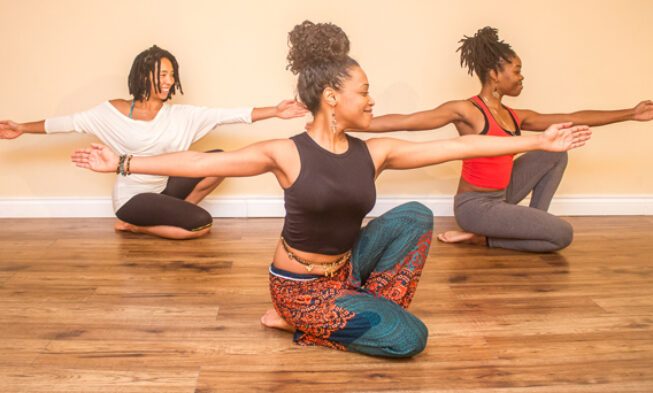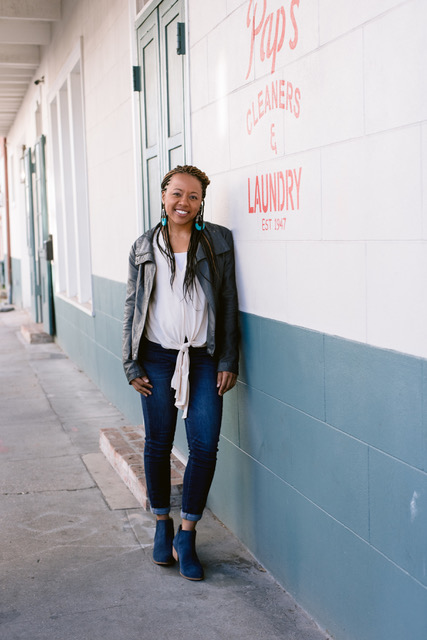Kemetic (Ancient Egyptian) Yoga

Kemetic Yoga (KY will be used as an abbreviation), which focuses on principals of the ancient Egyptian system of deep breathing, physical movement based on geometric postures, and mediation. It has begun to surge in popularity and interest again, but was developed in the 1970s. KY is derived from sages of Ancient Kemet and has several principles that include the ideas of vibration, gender, and rhythm. The postures are based on different gods and goddesses. For example, Neteru represents cycles of nature, Auset is undconditional love, Maat symbolizes balance and compassion (Maat Ka sequence).
At the end of May this year, I attended a Maat Ka class at The Tree South LA. The instructor, Lauren (Anu) Wolley Ross, got her start in yoga practice while working as a stressed social worker. She learned that yoga made her feel better and eventually became a certified teacher (Hatha and Kemetic). Lauren finds that yoga keeps her “centered…wave of energy over me…it knocks ego down and [ ] let it go.”
Listening to the passion that Lauren expressed about yoga, made it very clear why this form of yoga is aligned with her. She spoke about how much people of color need to cultivate the practice due to the amount of anxiety we experience in dealing with the world, living in a fast-paced society, as we “try to survive, while not actually surviving.” POC manage, we are experts in managing, but we aren’t adept at taking care of ourselves to counteract traumas (apply any variety of traumatic circumstances here) and survival. Although we do discuss or vent frustrations and concerns to one another in order to move forward, we don’t necessarily share how to repair and experience post traumatic healing and growth.
In yoga, Lauren explains, “we become more in-tune with our breath and breath changes your mind…It breaks illusions…gives thanks to our ancestors in recognizing a spiritual connection.” Our conversation deepened as she reviewed the history of yoga; how history left out our place in the foundation of yoga practice and how we can take control of our bodies to reclaim our culture, history, and develop pride. As one attendee, who joined our conversation, summed up our experience, in KY we have an “aura of guidance…protection coming from within, not without.”
During class I felt very comfortable with the poses, because Lauren did not focus on perfection. Being comfortable, understanding the names and purpose of each pose, and deep breathing were encouraged. Surrounded by steady drumming music and a spiritual inspiration, this class held more profound meaning for me. We need to practice Kemetic Yoga to cultivate space together, “elevate our energy and consciousness…it’s a way to create a portal to tune in.”
I quite enjoyed the experience, want to gain a better understanding of Kemetic principles, and how they compare to West African spiritual beliefs and deities. Hopefully our schedules align again soon, so I can continue to take classes with Lauren (Anu) regularly.
If you are interested in learning more about Kemetic Yoga, please visit Kemetic Yoga, Ausar Auset Society, and Khemetic Aha and Sema Association (KhASA). There’s also Soul Yoga Fest, held annually a variety of locations in the United States and abroad; Las Vegas, Chicago, Atlanta, France, South Africa, and Jamaica.
*Honest and transparent disclaimers: I originally began this post as an assignment for my travel class. My peers and me were tasked to write about highlights in our neighborhood as writers for a publication like Westways Magazine or Travel Magazine. Perhaps the idea of writing about new and very important material inspired a bit of doubt that eventually stunted my work. Despite my excitement about the travel genre, I felt less confident and had to put this work away for some time. And now, here I am. Embracing my novice perspective and taking a chance. **Also, I am fully aware that the woman in the first photo is not practicing Kemetic Yoga.
